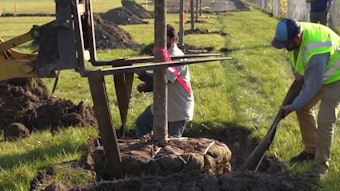Just like humans, fire ants head to where it’s cool and moist during the dog days of summer. But eventually they resurface to forage for food, usually making their way back to the surface at this time of year—just when kids are going back to school and your customers are having that last summer BBQ.
This year, the fire ant season may be longer than ever thanks to unusually hot temperatures throughout the South. “States that typically would stop treatment in late summer will now see fire ant activity well into the fall,” says Dr. Bobby Walls, product development manager at FMC Professional Solutions. “That’s why lawn care operators need to continue to inspect for any later-than-normal outbreaks.”
Fire Ant Facts
The red imported fire ant (RIFA) is an invasive ant species first introduced to this country in the 1930s through New Orleans. They are found throughout the southeastern United States from California to Florida and up to Maryland.
Fire ants behave much like regular ants except for two important differences—their painful stings and their aggressive attack methods. When disturbed, a single ant can alert the rest of the colony to attack as well, resulting in multiple stings, which can be dangerous for small children, pets and older adults.
Fire ants build their mounds just about everywhere: on turf, along driveways, in sidewalk cracks, around tree roots, near electrical boxes, etc. Fire ant mounds are usually dome-shaped with a network of underground tunnels extending as far as five feet. “If you disturb a fire ant mound, you are in for a surprise,” says Walls. “They pour out of the mound and immediately go into attack mode.”
Fire Ant Treatment
To keep your customers lawns safe, consider the following steps:
Identify. Inspect all areas of the property for the telltale sandy and cone-like mounds. These can be small or large, and are usually just a preview of what is below the surface. The ants have copper brown to reddish bodies, with the head usually a lighter color than the abdomen. They are smaller than native ants, at about an eighth to a quarter of an inch.
Treat. These days, granular insecticides are the preferred method of treatment as some offer both curative and preventive control and can be applied easily with spreaders. Lawn care operators can treat just the mounds, the perimeter of the property or the entire property. “Check to see that your treatment also controls other insects so you get the most bang for your buck,” says Walls.
Think fast. Often, lawn care operators get calls from customers who have just gotten stung, and they want to see quick results. One new product helping fit this need is Talstar XTRA Granular insecticide from FMC, which gives incredibly fast control while still providing season-long control. “Talstar XTRA is the fastest fire ant product on the market, eradicating ants in four hours or less, and often in as little as minutes,” says Walls. “You can treat your customers’ lawns in the morning, and they can be free of fire ants that afternoon.”
Follow-Up. If you’ve decided to treat just the mounds, be sure to inspect your customers’ lawns every two weeks, especially if there are children or pets at the home. Granular treatments will also prevent other pests so it’s a cost-effective solution for most consumers.


























